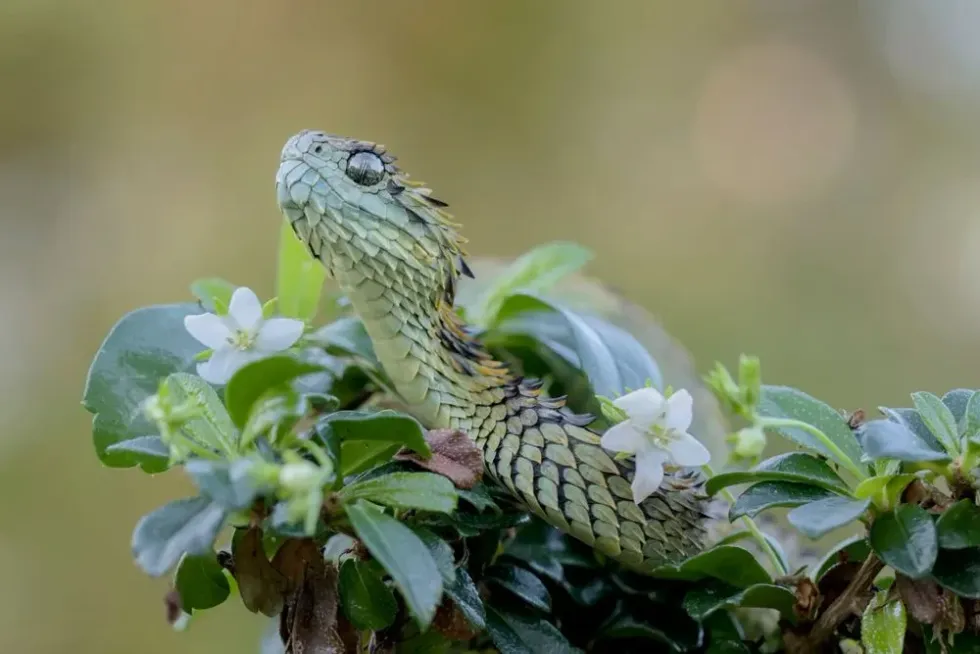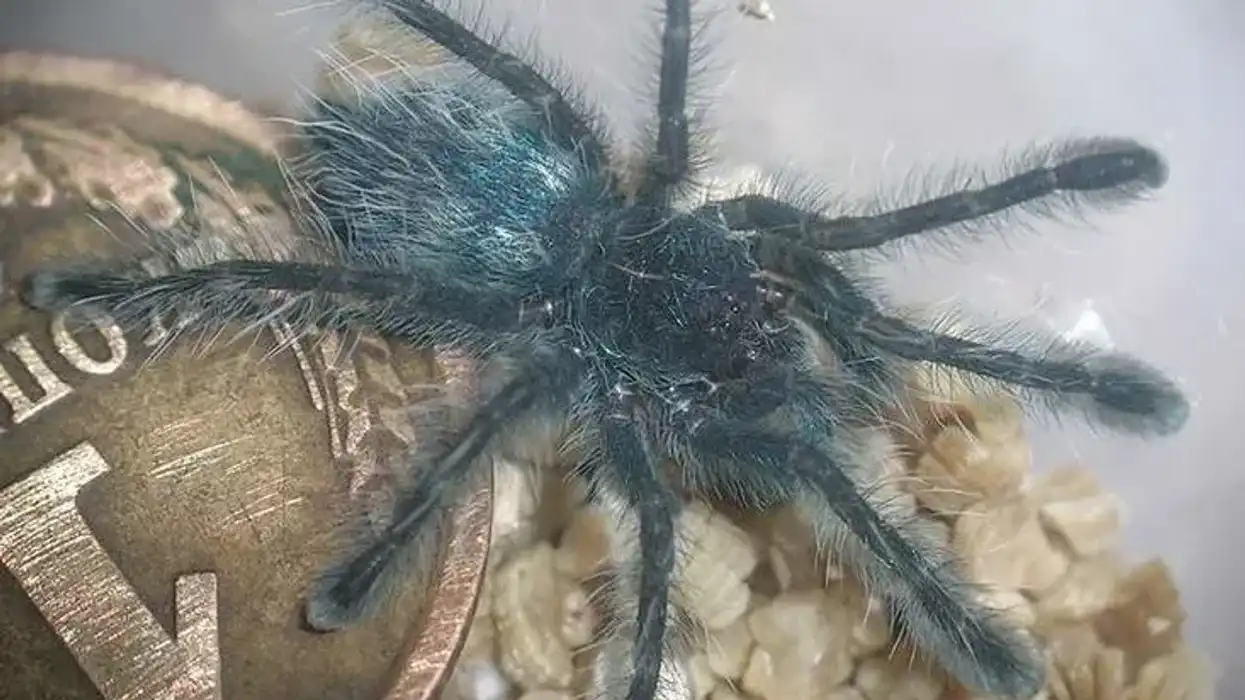The spiny bush viper (Atheris hispida), a venomous species best known for its keeled dorsal scales, is endemic to countries of East and Central Africa such as Congo, Kenya, Tanzania, and Uganda. The species is known by several names such as African hairy bush viper, rough-scaled bush viper, hairy bush viper, and many more.
The spiny bush viper possesses a slender body with green or brownish keeled scales that help it to camouflage. The scales give the species a spiny or bristly appearance, easily merge with the environment, and help the snake to hunt and get overlooked by the potential predators.
The average weight and height of the bush viper are 4.40-8.81 lb (2-4 kg) and 25.59-29 in (65-73.66 cm) respectively. The female viper is generally shorter than the male.
Spiny bush vipers are carnivores and primarily prey on birds, lizards, frogs, and mammals. One could find the vipers in rainforests, swamps, woodlands. The vipers also possess neurotoxic venom that is sufficient enough to injure several internal organs of humans as well.
The International Union for Conservation of Nature has not evaluated the status of the spiny bush viper species yet. Also, due to the solitary nature of the species, very less is known about its population.
Let's read more interesting facts about the spiny bush viper and if you found this article insightful, don't forget to check out exciting information about different animals like giant garter snake facts and African rock python facts.
Spiny Bush Viper Interesting Facts
What type of animal is a spiny bush viper?
The spiny bush viper (Atheris hispida) is a venomous snake species endemic to a few countries of Central and East Africa. The species has a slender body with keeled scales and is known by different names such as African hairy bush viper, rough-scaled bush viper, hairy bush viper, and many more.
What class of animal does a spiny bush viper belong to?
The spiny bush viper snake belongs to the class Reptilia, the family Viperidae, and the genus Athris.
How many spiny bush vipers are there in the world?
There is no exact information regarding the population of spiny bush vipers as of now due to their solitary and nocturnal nature.
Where does a spiny bush viper live?
The spiny bush viper (Atheris hispida) is a native snake to countries of Central and East Africa such as Tanzania, Uganda, Kenya, and Congo. The species is found in isolated populations.
What is a spiny bush viper's habitat?
The spiny bush vipers primarily dwell in woodlands, swamps, and rainforests. Due to their exceptional climbing skills, high-altitude regions also serve as their habitat.
Who do spiny bush vipers live with?
Like other species of snakes, the spiny bush vipers are nocturnal and solitary and prefer to live alone. The snakes come together during the mating season. Also, the female snakes are not involved in any kind of parental care after birth.
How long does a spiny bush viper live?
The exact life span of the spiny bush vipers is not known as of now but several studies state that these snakes can live for more than 12 years in captivity. Generally, several species of vipers live for around 10 to 20 years.
How do they reproduce?
The mating season of the Atheris hispida snake generally occurs during the summer season and peaks in October. After two or three years, the snake reaches sexual maturity, male snake generally attains maturity much before the female snake. Before mating, the species is involved in several courtship displays that include body movements, facing each other, and many more.
Species of vipers generally follow the monogamous mating system, also the females are ovoviviparous which means the females develop the eggs within their bodies. After breeding, the females generally go through a gestation period that lasts for around six to seven months.
Females give birth to up to 12 young at a time. Like adult snakes, the young ones also possess dark green bodies with curly stripes.
What is their conservation status?
The International Union for Conservation of Nature has not evaluated the status of the spiny bush viper species yet but the population has been reducing over the years. Threats such as loss of habitat, human killings, and predation are highly affecting the species.
Spiny Bush Viper Fun Facts
What do spiny bush vipers look like?

The spiny bush viper possesses a slender body with green or brownish keeled scales. The scales are quite sharp at their heads, unlike the back while the tail of the snake helps to climb. The female is generally shorter compared to the male snake.
How cute are they?
The most fascinating thing about the spiny bush viper is the scales, the green or brownish keeled scales give the species a bristly appearance. The green scales easily merge with the environment and the most pleasant experience would be to watch them hunting their prey.
How do they communicate?
Like other reptile species, the Atheris hispida snakes follow the same methods of communication. They generally lift their front part in the air after feeling threatened.
Males generally try to show their dominance while fighting with other males. Also, females and males are involved in several courtship displays such as tail waving, body rubbing, rhythmic body movements, and biting each other. The snakes also use the sense of smell and touch as the mediums of communication.
How big is a spiny bush viper?
While talking about the spiny bush viper size, the average weight and height of the spiny bush viper are 4.40-8.81 lb (2-4 kg) and 25.59-29 in (65-73.66 cm) respectively. The snakes are thrice the size of worm snakes. The spiny bush vipers are also slightly bigger than common garter snakes.
How fast can a spiny bush viper move?
The exact speed of the spiny bush viper is not known as of now but the snake is known for its exceptional predatory skills. The snake usually hangs on the tree waiting for the prey and attacks instantly.
How much does a spiny bush viper weigh?
The average weight of the spiny bush viper is 4.40-8.81 lb (2-4 kg).
What are the male and female names of the species?
There are no specific names given to the males and females of the species. Males are generally larger than females.
What would you call a baby spiny bush viper?
People usually use terms such as 'snakelets' and 'neonates' to refer to the babies of the spiny bush viper.
What do they eat?
The Atheris hispida species primarily prey on birds and other small animals such as shrews, tree frogs, and lizards. The spiny bush viper sometimes often makes other species of snakes its prey.
Are they poisonous?
The spiny bush viper is quite dangerous as the species is regarded as a venomous species. The snake possesses a venom gland located on the upper jaw.
The neurotoxic venom is sufficient enough to harm humans and damage their internal organs. Also, there is no antidote available for the spiny bush viper bite. If it remains untreated, the bite could cause death as well.
Would they make a good pet?
Generally, people do not consider the spiny bush vipers as pets as they are highly venomous and unpredictable. These snakes can attack at any moment and one should never keep them with other pets. It is always advised not to keep them but you can find these ferocious snakes in several zoos around your house.
Did you know...
A Belgian herpetologist, Raymond Ferdinand Louis-Philippe Laurent gave the scientific name to the spiny bush viper.
The tail of the bush vipers generally attracts their prey.
Do spiny bush vipers have predators?
The spiny bush vipers are generally preyed upon by several species of snakes in the wild. Also, humans have emerged as a threat to these snakes. They generally use their scales to get overlooked by potential predators. The population of the spiny bush vipers has been reducing constantly for many decades.
Comparisons with other bush vipers
There are around 17 species of bush vipers that belong to the genus Atheris. These species are the acuminate bush viper, Barbour's short-headed viper, Usambara bush viper, West African bush viper, Mount Kenya bush viper, Hetfield’s bush viper, Tai hairy bush viper, and many more.
The major differences among all are the size, appearance, and location. Species such as the Katanga Mountain bush viper are around 16 in (40 cm), almost half the size of the spiny bush viper. While Halloween's green tree viper is twice the size of a spiny bush viper.
Numerous species of bush vipers are arboreal but some of them are also found on grounds. Species such as the Mount Mabu forest viper, west African forest viper are not found in eastern and central regions of the continent.
The African spiny bush viper, also known as the green bush viper dwells in forests of low elevations ranging from 328 to 1312 ft.
While the spiny bush viper also inhabits the high-altitude between 2,900 and 7,800 ft. A few African spiny bush vipers are found in either yellow or reddish color, unlike spiny bush vipers. The females of the former species give birth to 19 neonates while the latter produces around 12 babies.
The males of the spiny bush viper are longer compared to females, unlike the African bush viper.
Here at Kidadl, we have carefully created lots of interesting family-friendly animal facts for everyone to discover! Learn more about some other reptiles including sea snake facts and copperhead snake facts.
You can even occupy yourself at home by coloring in one of our viper coloring pages.










